Report
Gen Alpha unfiltered
A deep dive into the minds, values, and behaviors of the youngest generation

Jump into the trend you’re most curious about
And yes - they’re already shaping it.
Whether it’s what goes in the family shopping basket, what games are topping the download charts, or what careers they aspire to, Gen Alpha are quietly but confidently influencing culture, tech, and decision-making.
But what they’re doing is just half the picture. These are the consumers of tomorrow - and understanding what their actions mean gives us a powerful window into the future. This is a generation growing up with agency, autonomy, and plenty to say.
So here it is - straight from the source. Gen Alpha, unfiltered.
Key insights
They’re curating their calm
IRL is trending
The future looks female
They’re scrolling more and posting less
Little shoppers have loud opinions
01
How do Gen Alpha think?

Between media buzz, TV shows like Adolescence, and think-pieces at every turn, Gen Alpha have already landed in the spotlight - all before they’ve even left the classroom. But how much of what’s being said actually reflects reality? And are growing concerns about this generation warranted?
A generation under the microscope
Ask adults what concerns them most about Gen Alpha’s future, and you’ll get a long list. Climate change. Cost of living. Political division. Mental health. Social media addiction. The fear among many is that this generation will grow up more anxious, more distracted, and less connected than those before them.
Our biggest fears for Gen Alpha
% of adults who say the following are their biggest fears for the next generation
- Source: GWI Zeitgeist June 2025
- Base: 12,195 consumers aged 16-64 (16+ in select markets) in 11 markets
Already a GWI user? Explore the data on the GWI platform
- Source: GWI Zeitgeist June 2025
- Base: 12,195 consumers aged 16-64 (16+ in select markets) in 11 markets
Already a GWI user? Explore the data on the GWI platform

And yes, they’re growing up in a world that feels increasingly uncertain. But zoom in, and you’ll get a more nuanced picture - one that suggests they’re adapting, not shutting down.
Podcasts in, panic out
Gen Alpha are carving out their own set of priorities and adjusting to the world around them. Compared to 2021, their ranked order of interests has been rejigged, and this tells us a lot.
One key shift: technology has overtaken computers as an interest. That might sound like semantics, but it reflects something bigger. While Gen Alpha spent plenty of time on computers during the pandemic - logging into virtual classrooms and learning remotely - it hasn’t translated into lasting enthusiasm for the devices themselves. They’re used to accessing the internet from the palms of their hands, through smartphones, tablets, and smart speakers.
They’re not drawn to hardware for its own sake - it’s about what it enables. The focus has shifted from “look at this high-tech device” to “look what I can do with it.” Their interface with the digital world is smooth, intuitive, and embedded in their everyday, not confined to a desk.
Where teens' interests are migrating
Ranked order of interests over time, based on the % of 12-15 year olds who say they're interested in the following
- Source: GWI Kids Q1 2021 & Q1 2025
- Base: 16,428 12-15 year olds in 14 markets
Already a GWI user? Explore the data on the GWI platform
- Source: GWI Kids Q1 2021 & Q1 2025
- Base: 16,428 12-15 year olds in 14 markets
Already a GWI user? Explore the data on the GWI platform
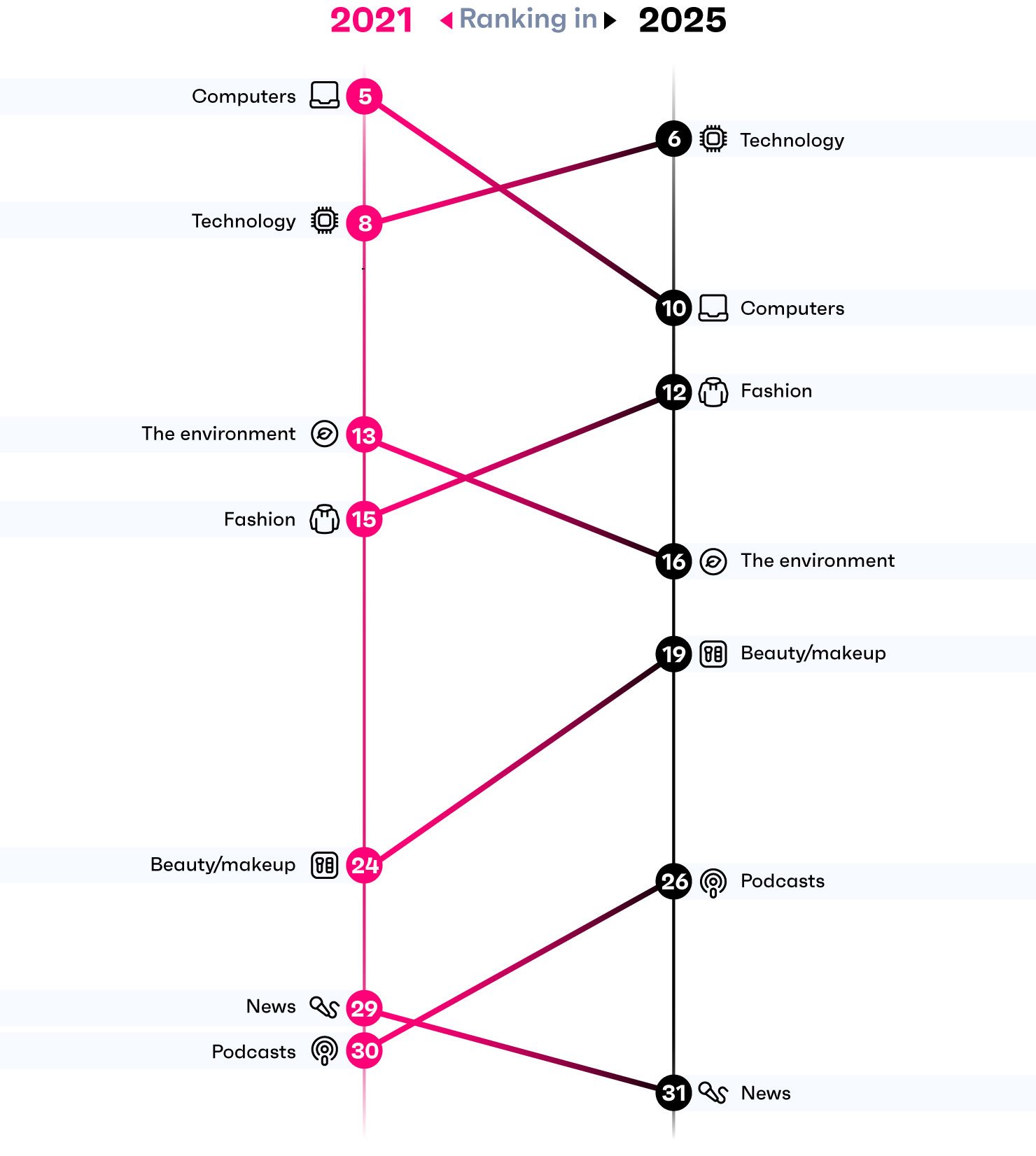

Blog
Gen Z vs. Gen Alpha
Explore the surprising ways these generations diverge (and align).
Read moreAnother big switch up is that Gen Alpha are now more interested in podcasts than the news, and less are showing an interest in the environment. With constant exposure to global crises on their feeds, economic stress filtered down from their parents, and polarized discourse at every turn, kids are likely overwhelmed. Much like adults, 15% of whom avoided political content last year because it impacted their wellbeing, kids are tuning out to protect their mental health.
Attention is finite, and they’re choosing to spend it where it feels lighter, safer, or more within their control. For brands and publishers looking to connect in ways that resonate, it’s worth thinking about the formats Gen Alpha gravitate toward - like audio or video. Keep it conversational, solutions-focused, and aligned with how they already engage.
Expression gets serious
Beauty, makeup, and fashion are climbing the ranks of Gen Alpha’s top interests - especially among boys. In the UK, the share of teen boys interested in beauty or makeup has more than doubled since 2022, from 4% to 9%. What used to be considered “just play” - dress-up, imitation, curiosity - now comes with more access, options, and purchasing power. And the appetite is clear.

But as interest grows, so does the risk. Kids are experimenting with products made for adult skin, sometimes without understanding what’s appropriate for them. It’s no wonder some companies are stepping in. Kiehl’s launched a campaign warning against the rise of 10-step routines for under-15s, and Swedish pharmacies banned the sale of certain products to children.
Brands can also be positive role models for kids eager to express themselves. Those that succeed will be the ones who meet Gen Alpha with honest messaging, age-appropriate products, and clear boundaries. Indeed Labs is one example, leading with formulas designed for younger skin.
And when it comes to spreading the word? Influencers matter. Beauty and makeup-loving 12-15 year olds are 55% more likely than their peers to say they find out about products from celebrities or content creators. That’s a powerful lever that comes with responsibility. Companies should use these voices not just to sell, but to clearly signal who their products are actually for.
Ask our customers
In Gen Alpha’s eyes, creators and influencers aren’t just seen as sources of information – they are worthy of fandom that has surpassed athletes and even celebrities in terms of breadth of audience, and more importantly, depth of influence. All brands should be paying close attention to how their use of creator marketing can shape the way they ethically reach this generation, but beauty brands especially.
02
How do Gen Alpha play?

There’s a lot of evidence that excessive use of tech can cause kids to disconnect from the real world. But for a generation raised on screens, Gen Alpha are flipping the narrative: they’re turning them off (at least sometimes) in favor of more hands-on, real-world fun.
Screens down, heads up
Five years on from the height of the pandemic - an event that stole school terms, birthday parties, and weekend meetups - Gen Alpha are rediscovering the joys of offline life. There’s been a noticeable rebound in “IRL” fun, with 12-15 year olds increasingly enjoying walking vacations, cinema trips, and seeing friends on weekends.
Kids are logging off to live it up
% change in the share of 8-15 year olds who/whose...
- Source: GWI Kids Q1 2021 & Q1 2025
- Base: 31,909 8-15 year olds in 14 markets
Already a GWI user? Explore the data on the GWI platform
- Source: GWI Kids Q1 2021 & Q1 2025
- Base: 31,909 8-15 year olds in 14 markets
Already a GWI user? Explore the data on the GWI platform
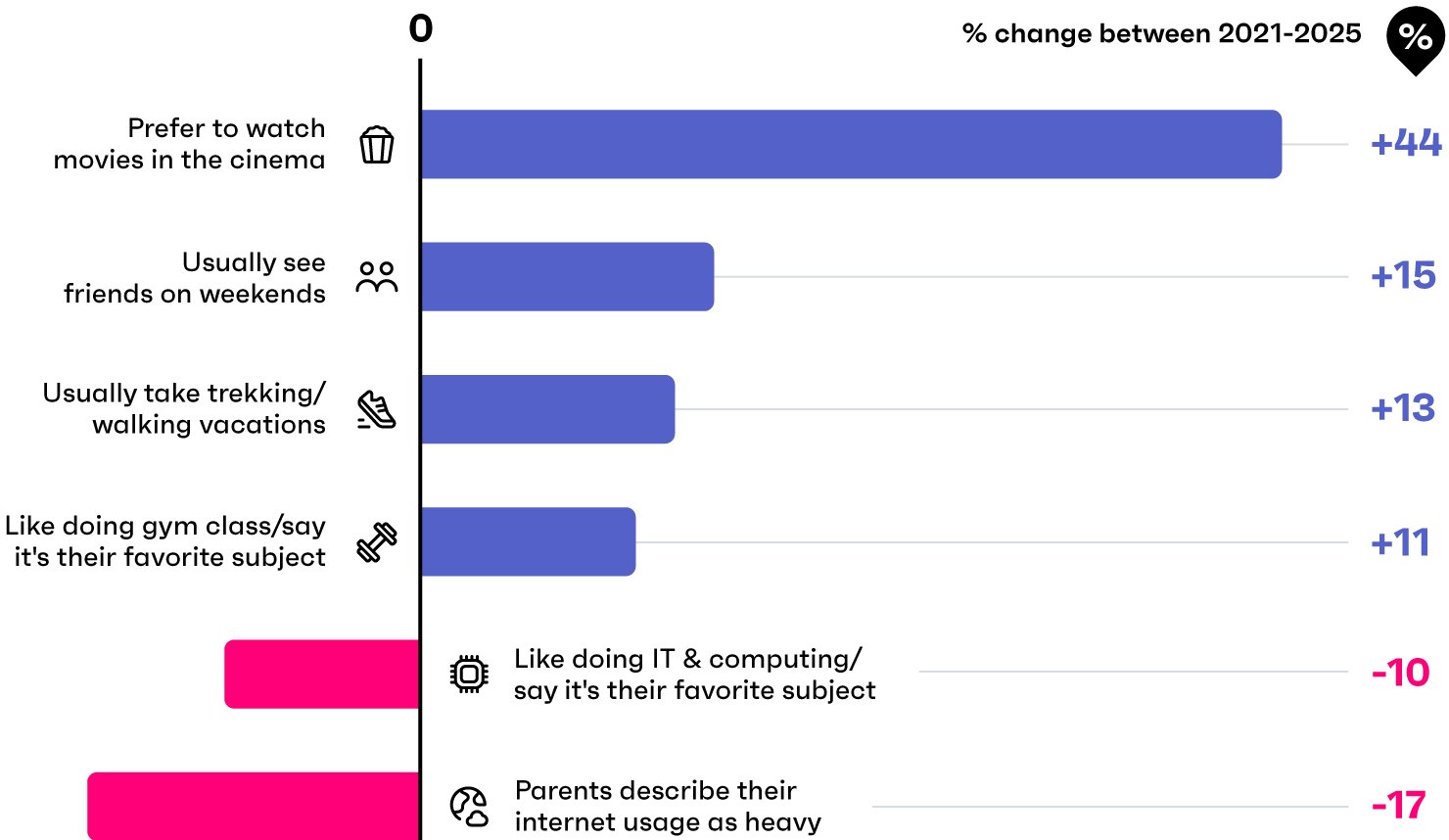
Even parents are less likely to describe their kids’ internet usage as heavy, suggesting a subtle shift in habits. Not a full-scale unplugging, but a recalibration. These kids still live digital-first lives, but they’re making room for exploration, movement, and in-person connection. In fact, 40% of 12-15 year olds say they take breaks from their devices - a sign that many are mindful about time online.
Other signs of this rebalanced approach to play? There’s been a 16% rise in kids with a physical toy on their wishlist since 2023, and an 8% rise in those saying they play board games a lot in that timeframe. So whether it's picking the cinema over streaming or leveling up their weekend hangs, Gen Alpha are making the offline cool again - literally out here touching grass.
Gaming gets social
Gaming isn’t going anywhere; 77% of 8-11 year olds play video games. What’s changing is what they’re playing, why they’re playing, and who they’re playing with.
Craft, create, connect
% of 12-15 year old gamers who say the following
- Source: GWI Kids Q1 2021-Q1 2025
- Base: 33,757 gamers aged 12-15 in 14 markets
Already a GWI user? Explore the data on the GWI platform
- Source: GWI Kids Q1 2021-Q1 2025
- Base: 33,757 gamers aged 12-15 in 14 markets
Already a GWI user? Explore the data on the GWI platform
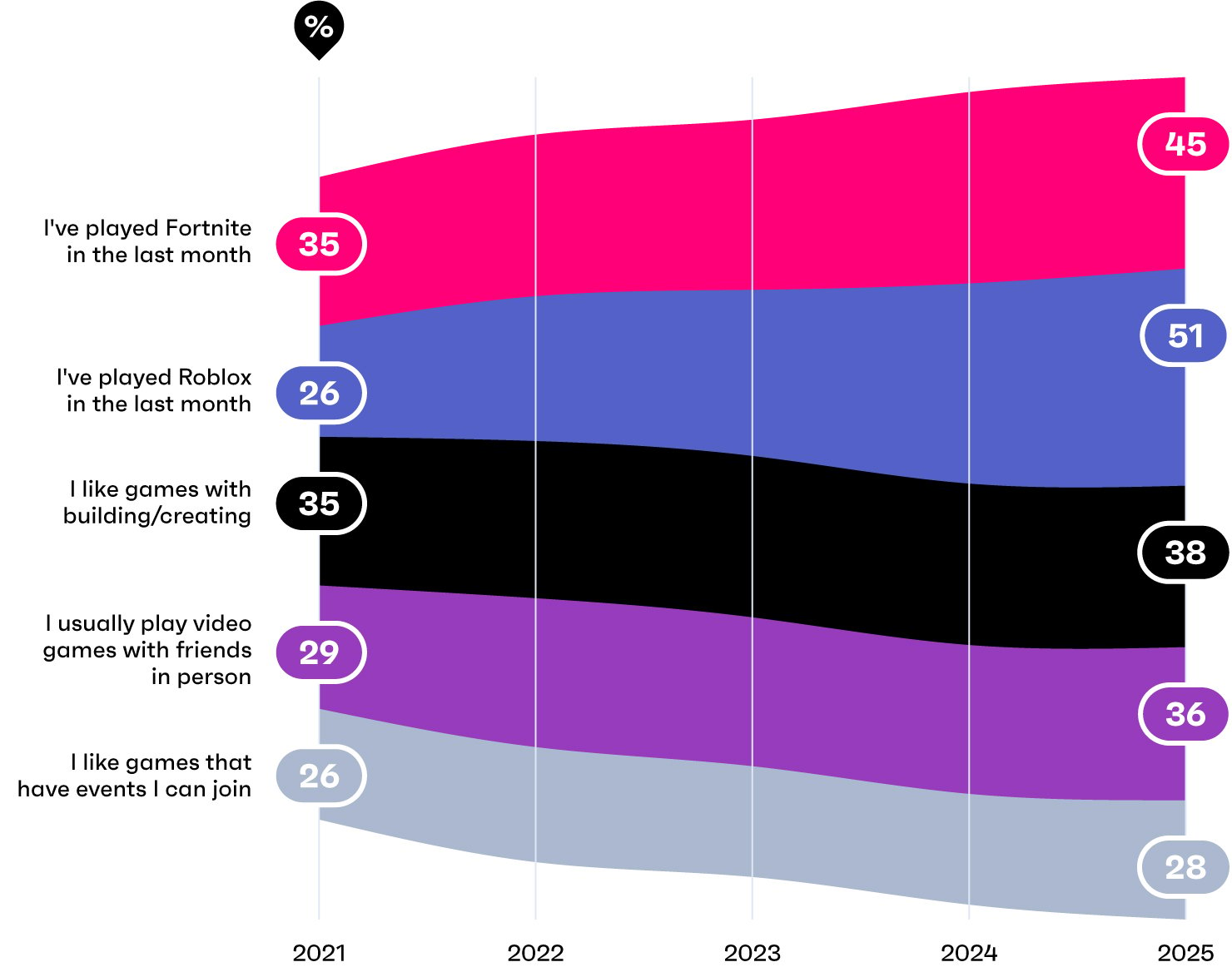
Today’s kids aren’t just logging on to play; they’re logging on to build, connect, and co-create. Right now, 38% of 12-15 year old gamers like titles with building or creating elements, and the surge in sandbox-style games like Roblox and Minecraft backs that up. Roblox has nearly doubled in usage since 2021, jumping from 26% to 51%.
Ask our customers
At Roblox, we’re helping to shape a new era of play: immersive, collaborative, and creative. For Gen Alpha, it’s about building worlds, forming friendships, and exploring ideas together. Users are empowered to create, solve problems, and express themselves in ways that blend the digital and physical. This shift is redefining what the next generation expects from gaming, and we’re proud to be part of that evolution.
So what does all this mean? Gen Alpha’s definition of play is layered and collaborative. It’s not just about entertainment - it’s about creativity and connection, both online and off. For brands, the takeaway is simple: create moments that bring people together. Whether it’s through party games, creative tools, or toys with digital tie-ins, the winners will be those who treat play as a shared, meaningful space.
03
What drives their ambition?

14% of adults fear the job market will fail Gen Alpha. But what if this generation has a different vision of success? When we understand what they’re aiming for, we can back them in ways that matter.
In some cases, the future really is female
Let's start on a high note. Today’s girls feel very empowered, even if Katy Perry’s space ride didn’t quite launch a new era of feminism. 54% of them believe girls can do any job they want, and this shines through in their career goals.
While STEM jobs are set to stay male-dominated for now, girls are considering a wide range of career paths. Traditionally, doctors, lawyers, or journalists have been male-heavy roles, but that’s changing. For the first time ever, the UK’s General Medical Council recorded more female than male doctors. And more to the point, our research suggests women will continue to overtake men in these professions, with more girls showing an interest in them.
Ask our customers
It’s inspiring to see how far we’ve come in empowering girls to believe they can do anything - and the data shows it’s working. But to reach true equality, we need to bring boys along for the ride too. That means offering them the same encouragement, positive role models, and sense of possibility that girls have increasingly enjoyed over the last decade. It's also worth pointing out that despite the strides made in empowering girls in the West, many continue to encounter misogyny and don’t always feel safe in public spaces. There is still work to be done for both boys and girls to thrive in a world where equality isn’t just a message, but a lived reality.
The gender gap in teens’ career aspirations
% of male/female 12-15 year olds who want to be the following when they grow up
- Source: GWI Kids Q1 2025
- Base: 11,452 12-15 year olds in 18 markets
Already a GWI user? Explore the data on the GWI platform
- Source: GWI Kids Q1 2025
- Base: 11,452 12-15 year olds in 18 markets
Already a GWI user? Explore the data on the GWI platform
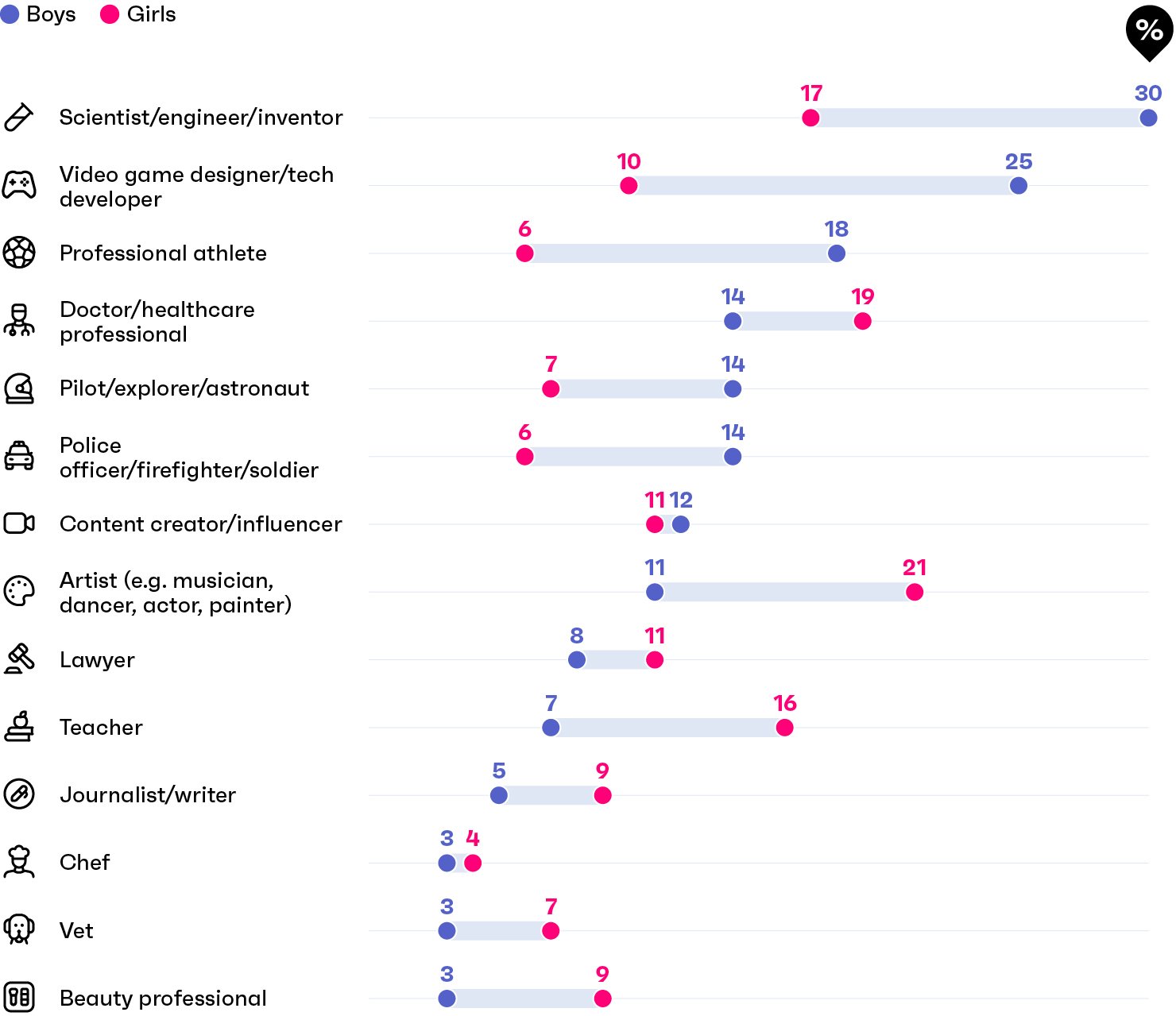
It’s a win for gender equality - but with fewer male role models in certain spaces, and just 37% of boys believing they can do anything, boys may need their own “you can do anything” pep talks soon. Teaching became female-dominated decades ago, and research suggests this is affecting boys’ engagement and performance. One solution? Working to recruit more young men.

Some industries may also struggle to recruit in general. Content creation looks fun and lucrative, while other jobs are seen as less glamorous. To engage tomorrow’s job seekers, industries will have to get their attention. In 2021, morticians started sharing the secrets of their trade on TikTok, and US student enrolment in mortuary science jumped 24% over 2020.
While content creation won’t become a full-time career for everyone, the mindset behind it - creative independence and passion-led work - is here to stay. Side hustles could be just as common for Gen Alpha as they are for Gen Z, and employers will need to keep pace with their expectations around flexibility and personal development.
Goodbye blackboards, hello disruption
Old-school learning is also being turned on its head, with the youngest generation challenging how education should look.
There’s been a big drop in US teens valuing university, especially among those from medium income households (-24% since 2021), those who like building or creating games (-38%), and who watch educational videos online (-23%). If college is losing its pull here, it’s time to ramp up skills programs, bootcamps, and apprenticeships. Employers and online educators can help prevent degree-less Gen Alpha being shut out of careers by opening up new pathways. Digital work experience courses are a good shout.
Teens are rewriting the education playbook
% of 12-15 year olds in the US/UK who say it's important to go to university
- Source: GWI Kids Q1 2021-Q1 2025
- Base: 7,589 12-15 year olds in the US/UK
Already a GWI user? Explore the data on the GWI platform
- Source: GWI Kids Q1 2021-Q1 2025
- Base: 7,589 12-15 year olds in the US/UK
Already a GWI user? Explore the data on the GWI platform
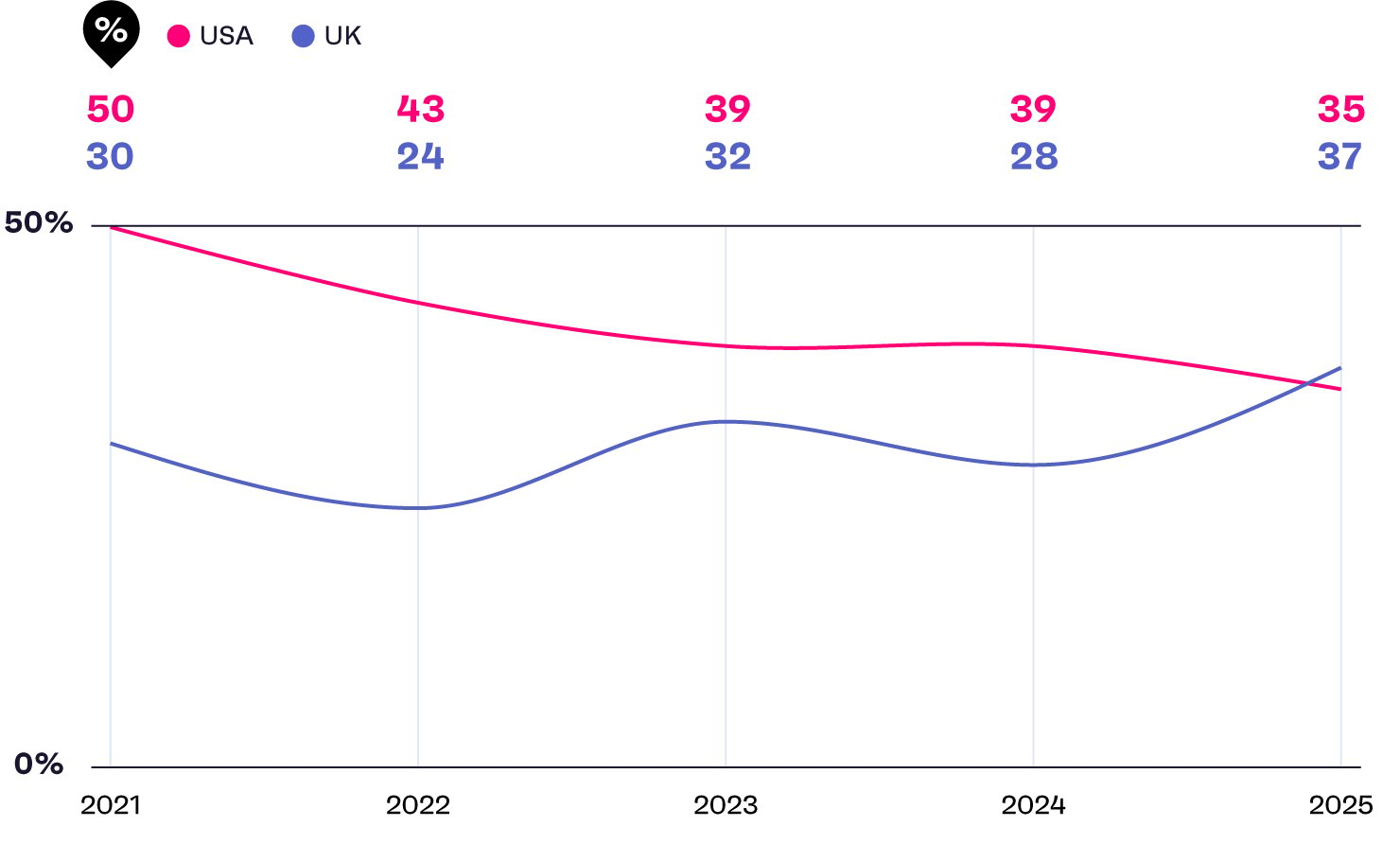

Turn insights into impact
See how GWI helps you spot trends early to craft campaigns that click.
Book a demoAs US teens back off college, their UK counterparts are leaning in - which presents a different set of opportunities and challenges. To keep degrees meaningful and relevant, universities could focus on aligning courses with job market demand to avoid an overflow of graduates in oversaturated fields. Employers also have a role to play; by collaborating with institutions to embed real-world skills into courses, they can ensure degrees are worth more than the paper they’re printed on.
Dodging the next digital divide
It’s not just job pathways that need addressing - AI could quietly rig the system. Whether AI fuels inequality or inclusion hinges on its design and oversight. According to Mustafa Özbilgin, a professor of organizational behavior, “AI reflects the values and inequalities of the world it’s created in”, so we need to tackle existing biases within these systems.
Beyond that, some groups are getting a headstart and will have a clear advantage in tomorrow’s workplace. Around 1 in 4 teens (regardless of their gender) say they’ve used an AI tool in the last week, which is impressive. But the likelihood of them doing this increases if they have young parents, are metropolitan, or live in a high income household.
By the time kids reach their teens, the gap might already be too wide to close, and early intervention could make a big difference. AI literacy should start in schools, with extra funding for underserved areas to level the playing field.
Some groups risk falling behind on the AI front
% of 13-15 year olds in each group who say they've used an AI tool in the last week
- Source: GWI Kids Q1 2025
- Base: 8,586 13-15 year olds who use at least one device in 18 markets
Already a GWI user? Explore the data on the GWI platform
- Source: GWI Kids Q1 2025
- Base: 8,586 13-15 year olds who use at least one device in 18 markets
Already a GWI user? Explore the data on the GWI platform
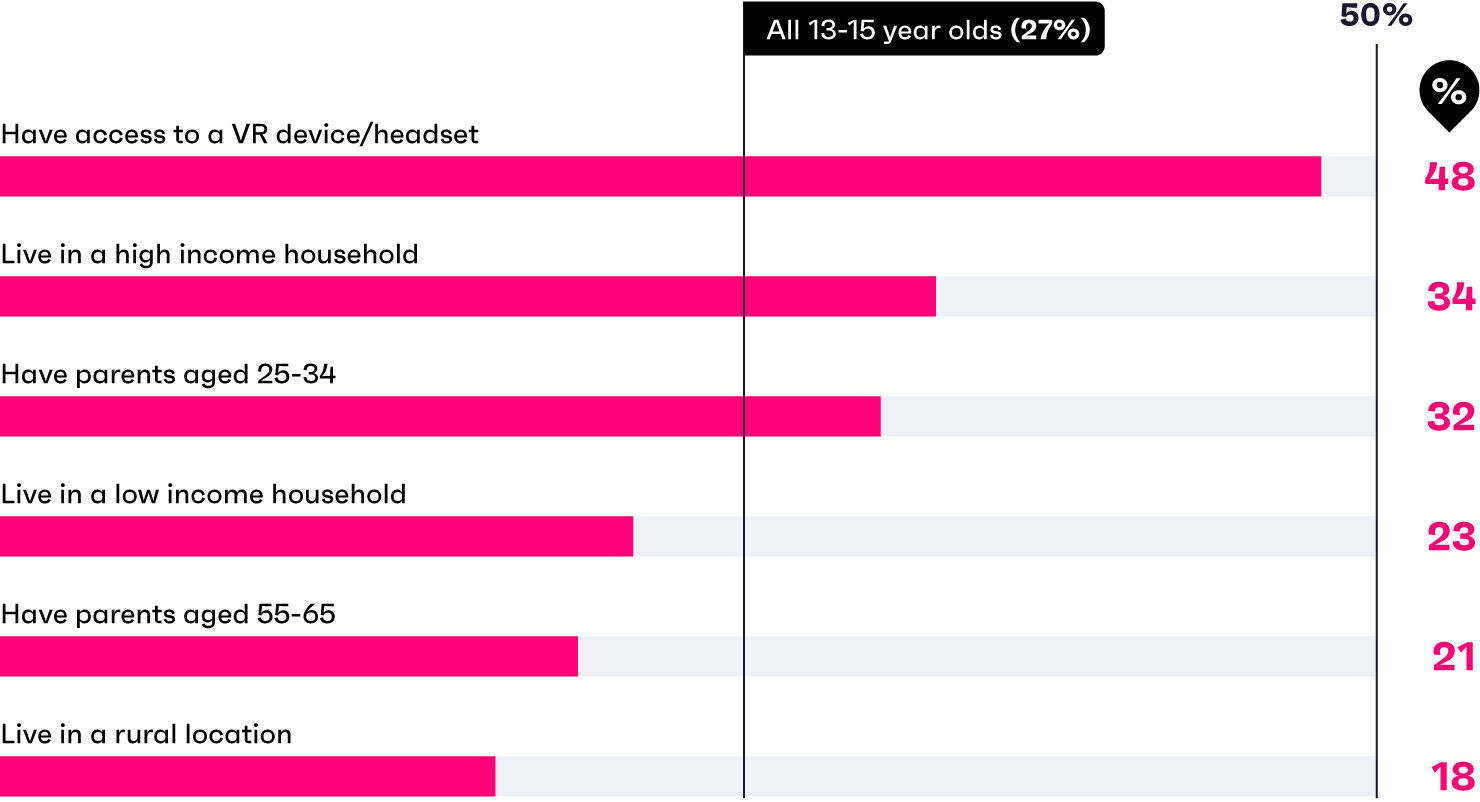
04
How do Gen Alpha scroll?

Kids today are more plugged in than any generation before them, and it’s raising real concerns about screen addiction. A massive 86% of 8 year olds have access to a smartphone or tablet, and by 13, nearly three-quarters have their own phone. Still, what’s happening beyond the scroll?
Plugging in, but not posting
Gen Alpha’s social media habits have taken a sharp turn toward consumption. They're increasingly logging in to watch, browse, and shop, with notable jumps in passive behaviors like following sports, spotting trends, and scouting out style inspiration.
What are they doing less of? Posting. Compared to 2021, fewer 12-15 year olds use social media to share opinions, read the news, or talk about causes they care about. Only 1 in 10 say they post everything they do, and just 2 in 5 feel able to post what they really think on these platforms.
Consume publicly, comment privately
% change in the reasons 12-15 year old social media users give for using it
- Source: GWI Kids Q1 2021 & Q1 2025
- Base: 15,947 12-15 year old social media users in 14 markets
Already a GWI user? Explore the data on the GWI platform
- Source: GWI Kids Q1 2021 & Q1 2025
- Base: 15,947 12-15 year old social media users in 14 markets
Already a GWI user? Explore the data on the GWI platform

Gen Alpha are digital natives, but they’re more cautious and guarded in their approach to online self-expression than we give them credit for. If you're a brand, think about how you show up in their feed. Visuals are their language: TikTok is their favorite platform, and not just for laughs. It’s where they go to find visual inspiration, whether that’s style, products, or creators they relate to. To earn their trust, don’t push them to speak. Give them something worth saving or sharing.

Report
The 2025 social media report
Build smarter strategies with global insights from nearly 1 million people.
Fuel your strategyAustralia spotlight: Teens are taking the social ban personally

With a social media ban for under-16s looming in Australia, it’s no surprise teens are vocalizing the value they get from these platforms. The belief that social media lets them say what they really think is up 41% year on year, while it’s stayed the same across the rest of the world. That’s not just a stat. It’s a signal. They’re carving out space for it while they still have it.
At the same time, teens in Australia are placing more importance on how their profiles look and what other people say about them - while teens elsewhere are heading in the opposite direction. Whether it’s self-expression, identity, or just habit, one thing’s clear: these platforms matter to them. And they’re not ready to log off without a fight.
Teens guard their digital territory
% change in the share of 12-15 year old Australian/global social media users who say the following about it

Source: GWI Kids Q1 2024 & Q1 2025 • Base: 976 12-15 year old social media users in Australia, and 20,637 in 17 markets • Question: Which of these do you agree with about social media?
But where will kids pivot to should their platforms of choice get taken away? We could see more time spent on video games for one, the type of media kids estimate they spend the most time on during weekends. Don’t just watch where they go, understand why - and be ready to meet them there.
Parenting online: Talk first, tech second
Parents are ramping up their efforts to protect kids online. Since 2021, there’s been a steady rise across all forms of digital controls, from setting parental restrictions to using PINs for sensitive content. Time limits, content filters, and privacy settings are all becoming more common.
More parents are setting up controls
% of parents who say they do the following to protect their child's privacy online
- Source: GWI Kids Q1 2021-Q1 2025
- Base: 80,063 parents/guardians of kids aged 8-15 in 14 markets
Already a GWI user? Explore the data on the GWI platform
- Source: GWI Kids Q1 2021-Q1 2025
- Base: 80,063 parents/guardians of kids aged 8-15 in 14 markets
Already a GWI user? Explore the data on the GWI platform
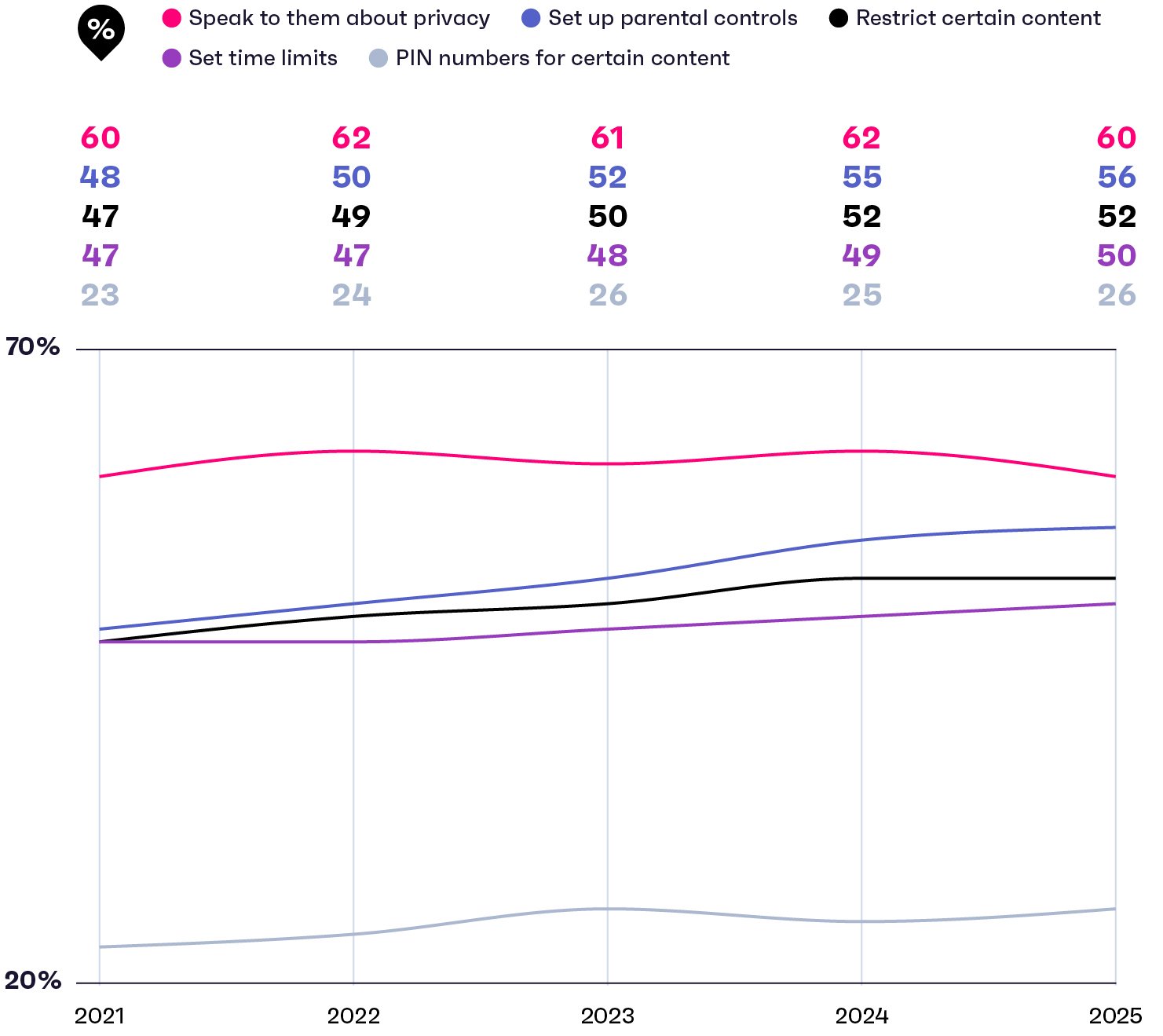
But here's the thing: while these methods are far better than doing nothing, kids whose parents talk to them about privacy are 10% more likely to believe they know how to be safe online than kids of parents who set up parental controls.
For brands: yes, make the tools. Build the platforms that set up boundaries; Meta and Snapchat, for example, have introduced safety measures for teenage accounts, while Spotify and YouTube have kid-curated versions of their platforms available. But there’s also an opportunity to go one step further.
Smart brands won’t just offer the stick, they’ll offer the carrot. That means supporting parents with conversation starters, educational resources, and content that empowers rather than polices. It’s about co-piloting, not controlling.
Ask our customers
Social media is a major source of inspiration, trends, and quick-fire knowledge for Gen Alpha - it’s fast, engaging, and often helpful. But with so much information at their fingertips, the ability to separate fact from fiction is more vital than ever. It’s an area where both educators and parents need to step in, helping kids build the critical thinking skills they’ll need to navigate a noisy, and sometimes misleading, digital world.
05
How do Gen Alpha choose?

While adults fear the cost of living crisis most for Gen Alpha, it helps to know how they’re navigating it. We’re giving you the lowdown on their financial freedoms, spending habits, and just how many V-bucks they’re charging to mom and dad’s credit card.
Sitting in the ecommerce driving seat
% of 12-15 year olds who say they've bought something online in the last week
- Source: GWI Kids Q1 2021-Q1 2025
- Base: 41,482 12-15 year olds who use at least one device in 14 markets
Already a GWI user? Explore the data on the GWI platform
- Source: GWI Kids Q1 2021-Q1 2025
- Base: 41,482 12-15 year olds who use at least one device in 14 markets
Already a GWI user? Explore the data on the GWI platform
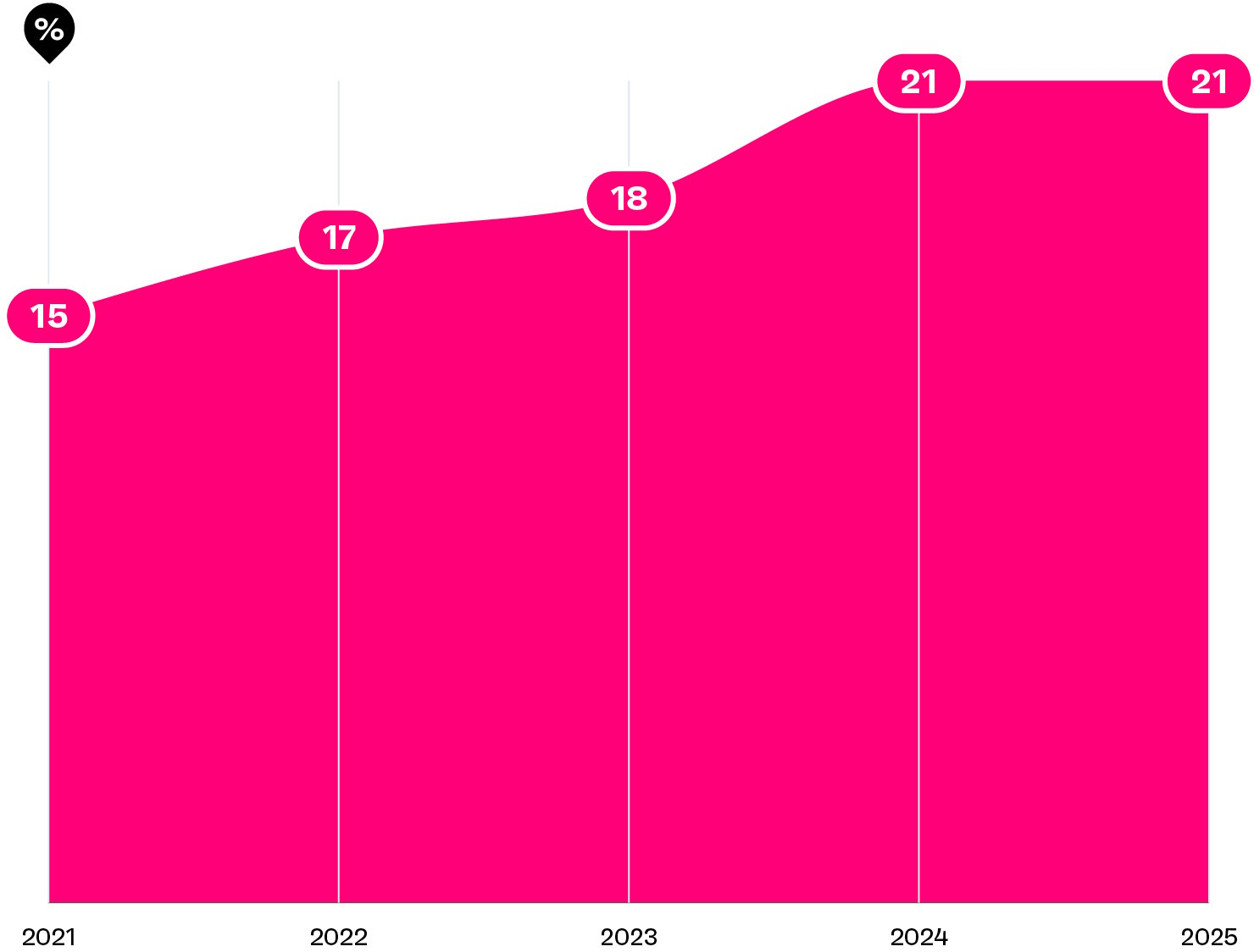
Learning to shop online
The share of 12-15 year olds buying products online each week has jumped from 15% in 2021 to 21% today. Gen Alpha aren’t just window shopping online, they’re checking out.
This behavior has increased alongside their spending power. In 9 of the 14 markets we surveyed in 2021, kids’ pocket money has increased at least 10% over the last four years. In the UK, kids are now receiving 25% more money than they were back then, outpacing inflation over that time period.
Others aren’t so lucky and are feeling the cost-of-living squeeze. Whether it's fewer impulse buys or tighter household budgets, there’s a clear signal that financial pressures are hitting home, even among the youngest consumers. In select markets like the US and China, kids are receiving less funds than they were a few years ago.
Ultimately though, kids in all markets have more freedom when it comes to buying online, regardless of how much money they get. With more freedom comes more responsibility, and the need for more information. Over a quarter of 8-11 year old gamers are spending pocket money on virtual, in-game items. More kid gamers are spending their money on these items than they are clothes in the real world. With no tangible product or physical transaction, measures have to be put in place before things get out of hand.
If you’re a bank, fintech, retailer, or payment platform, the message is clear: a little support can go a long way in helping kids take charge of their financial futures. Create safe spaces where teens can spend, save, and learn, and show parents that financial literacy can and should start early.
In short? Treat Gen Alpha like the consumers they are - just with the training wheels still on.
Ask our customers
Digital and contactless payment capabilities aren’t novel to this generation; it’s all they’ve ever known. At the convenience store, with their friend, within the games they play or the sites they browse, seamless purchasing is table stakes. One-click shopping and two-hour delivery are the baseline. Brands may need a reality check that what they define as innovative may be viewed as the bare minimum to digitally native Gen Alpha.
The democratic household
A clear majority of 8-11 year olds have a say - or even the final say - on everything from toys to food. Nearly 60% of kids spend their pocket money on food, their top purchase category. And when it comes to toys, around a third claim they decide alone.
What we’re seeing here is the power of the mini co-pilot. They may not hold the purse strings, but they’re firmly in the decision seat. This isn't just about them pestering parents at checkout. It’s about collaborative, even autonomous decision-making being the norm.
The democratic decision-making process
% of 8-11 year olds who say their parents/they hold responsibility for the following purchases
- Source: GWI Kids Q1 2025
- Base: 10,050 8-11 year olds in 18 markets
Already a GWI user? Explore the data on the GWI platform
- Source: GWI Kids Q1 2025
- Base: 10,050 8-11 year olds in 18 markets
Already a GWI user? Explore the data on the GWI platform
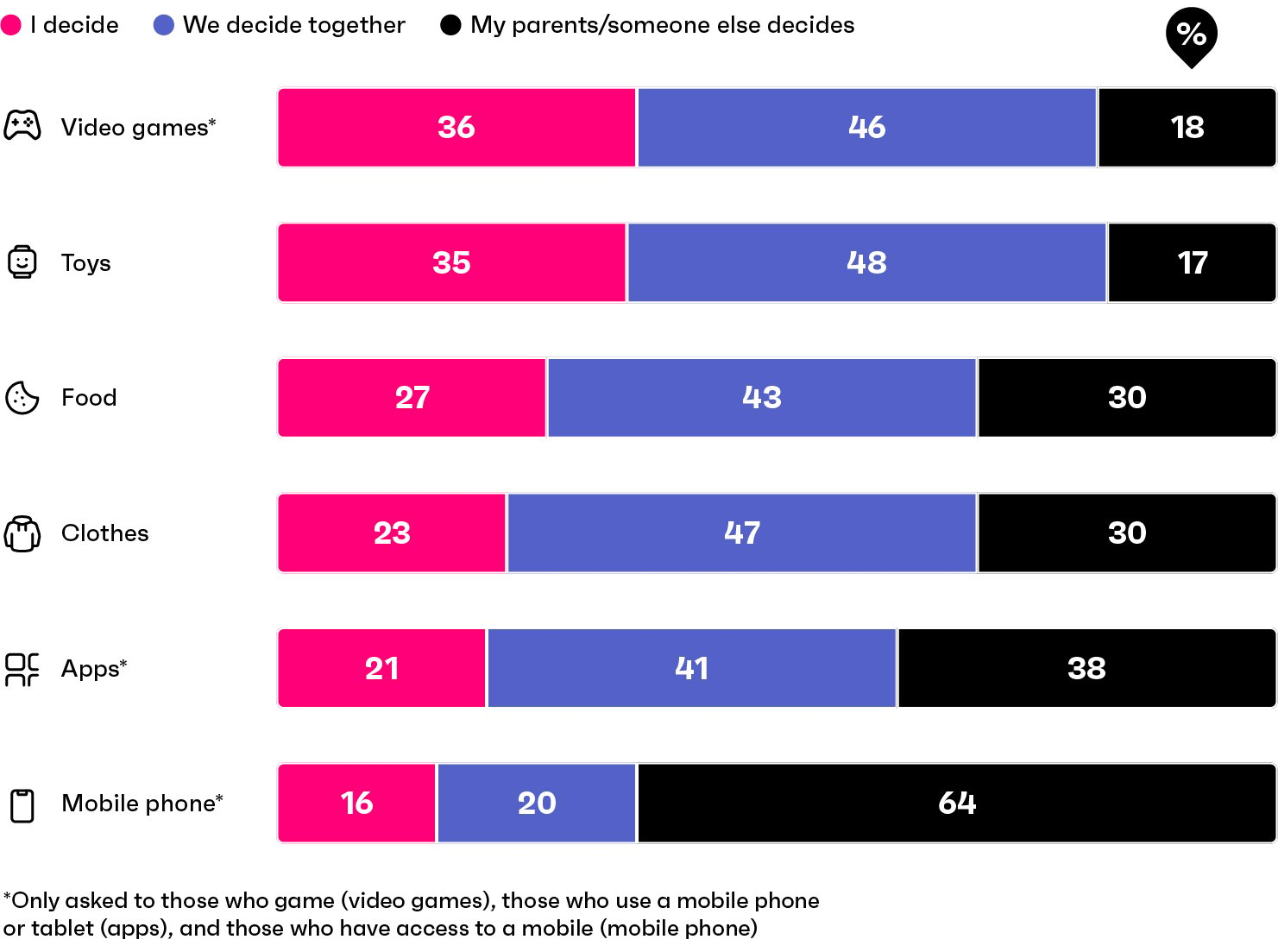
And they’re leaving their mark on the purchase journey. When it comes to food, more 12-15 year olds in North America say influencer recommendations are most important when picking a snack than a traditional marketing incentive like a free collectable sticker or card. Influencer-backed drinks and snacks, such as Prime, have become signature products in top creators’ merchandising arsenal.
It’s not enough to speak to parents anymore - kids are the ones picking the brands and influencing what goes in the trolley (or the online basket). But be wary - safety is key. When creating consumable products for this generation, cutting corners can lead to bad results, losing the trust of the parents in the schoolyard, who have the power to put their foot down.
What happens when kids call the shots
Decision-making power = digital exploration. Kids with more of it are especially likely to use mobile phones unsupervised, play games with strangers, and hang out on apps like Reddit than average. It’s a bit of a chicken and egg situation as we can’t say for sure which came first - whether their digital confidence earned them more autonomy, or their autonomy encouraged more digital confidence - but the link is undeniable.
Almost half of teen decision-makers say that being treated their age is important to them. They’re more digitally fluent, socially aware, and likely to describe themselves as open-minded, creative, and confident.
The influence of decision-making
Teens in each group who are the following times more likely to do/say these things than the average 12-15 year old
- Source: GWI Kids Q1 2025
- Base: 8,473 12-15 year old decision makers & 6,886 non-decision makers in 18 markets
Already a GWI user? Explore the data on the GWI platform
- Which of the following device(s) can the child taking this survey use unsupervised?
- Do you have your own mobile phone?
- If you could guess, what do you think you spend the most time doing after school?
- Which of these things are most important to you when picking a snack?
- Which of these do you use more than once a day?
- Who do you usually play video games with?
- Source: GWI Kids Q1 2025
- Base: 8,473 12-15 year old decision makers & 6,886 non-decision makers in 18 markets
Already a GWI user? Explore the data on the GWI platform
- Which of the following device(s) can the child taking this survey use unsupervised?
- Do you have your own mobile phone?
- If you could guess, what do you think you spend the most time doing after school?
- Which of these things are most important to you when picking a snack?
- Which of these do you use more than once a day?
- Who do you usually play video games with?
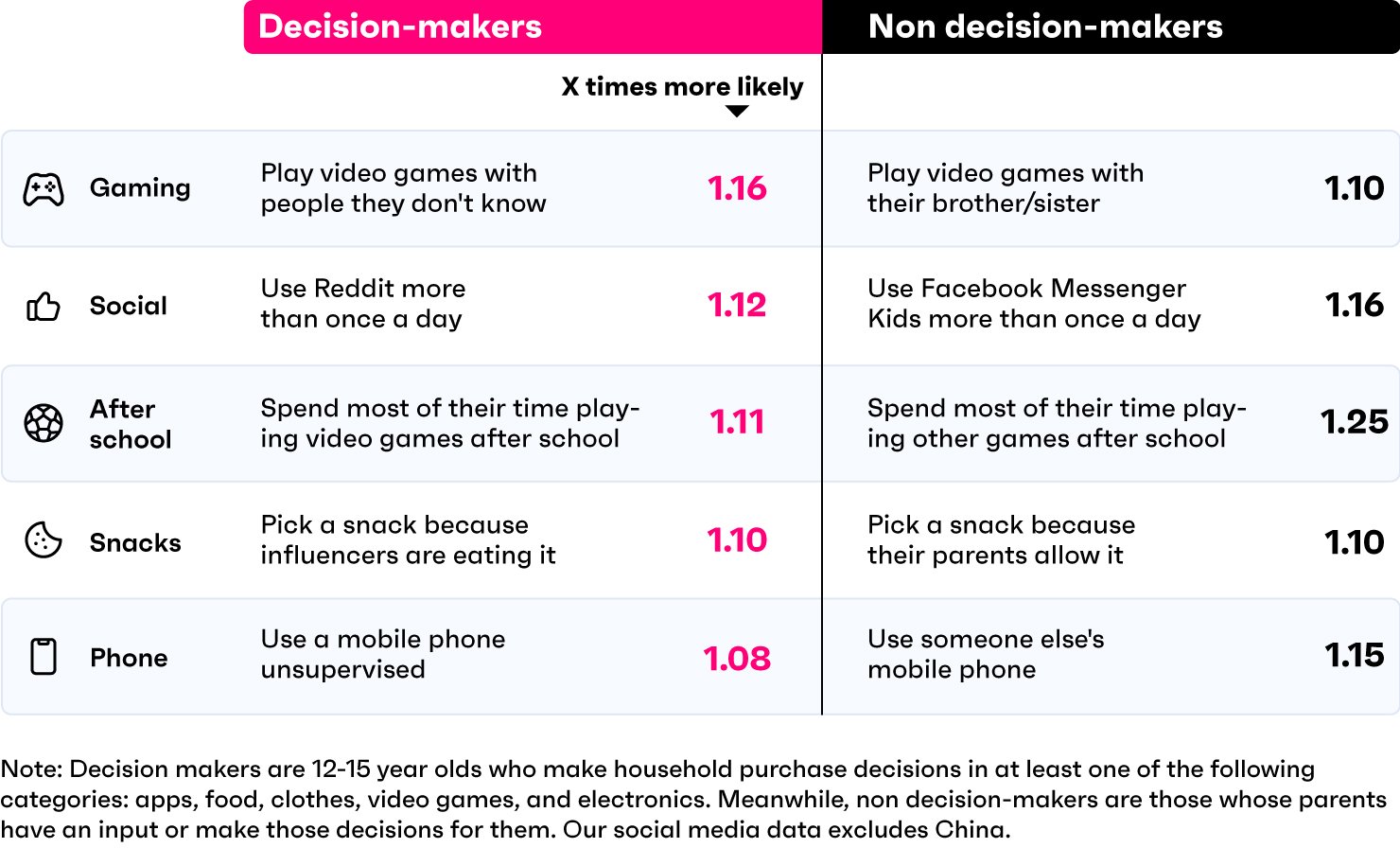
Like Australian social media users, these teens don't want to feel restricted. So be their toolkit, not their babysitter. Brands should aim to build safety nets that support their autonomy, rather than barriers that block it.
These kids are your future customers, but they’re making decisions now. You’ll find them on Discord, Reddit, and other gaming platforms, shaping their own digital experiences. Your messaging needs to be both empowering and responsible. So fuel their confidence, while respecting their age.
Now what?
This report has given you a front-row seat to the minds of Gen Alpha. You’ve seen how they think, play, dream, scroll, and choose. But more importantly, you’ve seen how fast the old playbook is becoming obsolete. If you're building strategies, campaigns, or products for this generation, good instincts aren’t enough. You need real insight.
Here’s the problem:
You don’t have clear visibility into what Gen Alpha actually care about
It’s hard to validate new trends without reliable, robust data
You’re trying to build marketing that lands, but you need insights you can trust
GWI solves all that.
With access to tens of thousands of surveys completed directly by Gen Alpha, paired with almost 2 million surveys from consumers worldwide, we give you the clarity and confidence to move from guesswork to action.
Whether you’re in media, tech, retail, or education, this is your chance to go deeper, faster. Because Gen Alpha aren’t waiting. So neither should you.

From data to decisions
Find out how GWI helps teams turn consumer data into confident, creative campaigns.
Book a demoNotes on methodology
GWI Kids represents kids aged 8-15 who use the internet. It does not therefore overlap with our adult surveys such as GWI Core and GWI Zeitgeist, although we may refer to them for context throughout this report.
Because children who don’t use the internet are not represented in GWI Kids, it’s important to remember that internet penetration rates vary significantly between the different markets included in the study (from highs of over 90% to lows of around 60%). The demographic composition of the online population may look very different from one market to the next.












